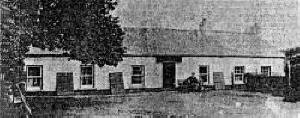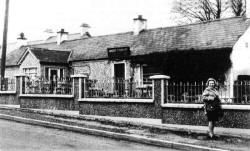
- Front Page
- Foreword
- Our Authors
- Acknowledgements
- Contents
- The Prehistory Of The Giant's Ring and Ballynahatty Townland
- Charley Family Houses In Dunmurry
- The Children Of William Charley (1826 -1890) Of Seymour Hill.
- The Charley Family Coat Of Arms
- A Protestant Pioneer Of Catholic Emancipation
- The Viking Origins Of The Viscounts Conway And Killultagh
- Lisburn Parliamentary Representatives In The 17th Century (1663-1700).
- Drumbeg 1860 - 1910: A Summing Up
- Lisburn's Charter Of 1662
- Round Towers In The Killultagh District
- The Crumlin Meteorite
- County Antrim Roots
- Book Review
- Historical Journals
DRUMBEG 1860 - 1910: A SUMMING UP
BY EILEEN BLACK
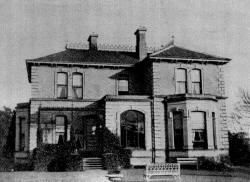 |
| fig. 1 : Drum House in the later nineteenth century, as designed by Thomas Jackson. (Photograph from R M. Young: Belfast and the Province of Ulster in the 20th century, 1909) |
The development of Drumbeg from the mid - eighteenth century until 1860 - the formative years of the area - has already been discussed by the author in previous volumes of this Journal.(1) That period saw the rebuilding of Drum Church (in 1798), the erection of imposing residences at Ballydrain and Wilmont and the opening of the Belfast - Lisburn stretch of the Lagan Canal and the Ulster Railway line between Belfast and Lisburn. The second half of the nineteenth century saw the further growth of the district, with the erection of the buildings such as the parochial hall, the school and the Orange Hall.
During this period, the church was again rebuilt, in this instance by the Belfast born architect, Sir Thomas Drew (later knighted).(2) Drew's building of 1868 - 70 replaced all of the original eighteenth century church, with the exception of the west tower (with its rebuilt spire of 1833) and part of the west wall. Inside, the building was graced by the addition of a number of fine stained glass windows, those in the apse being executed by the London firm of Messrs. Heaton, Butler and Bayne, those in the southern transept being by Ward and Hughes.(3) Members of the congregation gave handsomely to the internal fittings and fixtures; the tiled floor, the font (of Caen stone), the Bible desk and chancel chairs were donated by parishioners while Drew, who designed both the Bible desk and prayer desk, himself presented the latter. The cost of the building was about �2,500. To help create a suitably imposing approach up to the church, Captain Montgomery of Ballydrain gave the strip of land between the church and the road to the parish, at a nominal rent. The building was consecrated on 20 December 1870. A number of other changes subsequently took place in the vicinity of the church. The distinctive and imposing lynch gate, also by Drew, was added in 1878, the gift of Ellen Callwell (nee Montgomery), in memory of her brother, John Ferguson Montgomery of Ballydrain, who had died two years before.(4) In the next decade - 1885 -Thomas Montgomery of Ballydrain donated the avenue of yew trees, which sweep so majestically up towards the front entrance of the church. The rectory and parochial hall were erected c. 1896.
Drum House, close by the church, was likewise rebuilt during these years, by the well-known local architect, Thomas Jackson.(5) Jackson, whose clients included merchants James Bristow (Wilmont), Joshua Richardson (Old Forge) and James Richardson (tissue), had a number of fine buildings to his credit, including the Museum in College Square North, the Music Hall in May Street and St. Malachy's church, in Alfred Street. Drum House (fig. 1), a handsome and imposing residence, was built for John Amon, of the firm of John Amott and Co., Ltd., drapers and milliners of Bridge Street, Belfast The house id undated in Jackson's output, but may perhaps have been erected during the 1860s or '70s; in 1865, Jackson designed offices for Sir John Amott and Co., in Belfast's Royal Avenue. The earlier Drum House, known to posterity through Joseph Molloy's illustration in E. K. Proctor's Belfast Scenery in Thirty Views, published in 1832, was probably built in the late seventeenth century.(6) Little, however, can be seen of it in the drawing, as Molloy depicted it from the side, as part of a wider view encompassing the church and Drum Bridge.
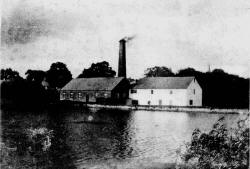 |
| fig. 4 : The Ulster Dye works on the Drumbeg Road, in the early years of the century. (Photograph courtesy Miss Bertha Thompson) |
Two important new buildings were erected on the Ballyskeagh Road during the 1890s: the school and the Orange Hall. The school was built by Mrs. Ann Jane Stevenson and Emily Charley in 1892, in memory of their brother, William Charley of Seymour Hill, who died in 1890.(7) Opened on 3rd October 1892 as Drumbeg National School, the name was changed to Charley Memorial School in April 1909.(8) It was, and remains, a lively part of the community and has turned out numerous "scholars" over the years.
The foundation stone of the Orange Hall was laid on 6th April 1896.(9) The ceremony was performed by R. H. Reade, owner of Wilmont and an important figure in the commercial life of Belfast.(10) Members of the local Orange lodge, Drumbeg Purple Star L.O.L. 638 were present, together with their friends and supporters from the district and Belfast.(11) Musical accompaniment for the occasion was provided by two flute bands: the Duke of York and a band from Purdysburn. The speeches, as were to be expected,
focused on Unionist politics and the Home Rule issue. The site for the building, which was thirty - six feet by eighteen and could accommodate four hundred persons, had been donated by Sir David Taylor, who had purchased Drum House in the spring of 1883.(12) (Taylor and John Amott, for whom Jackson had designed the house, were brothers - in - law). The arrangements for the handing over of the site had been carried out by Taylor's son, John Arnott Taylor, some time before his sudden death in November 1890.(13) By the time the foundation stone was laid, some f150 was outstanding to complete the erection of the hall. The building, of modest proportions, is decidedly functional in appearance. According to family legend, the author's great - grandfather, local blacksmith Samuel Dugan (see fig. 2) made the railings around the hall.
![]()
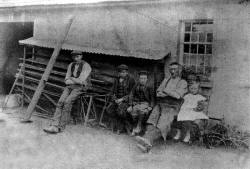 |
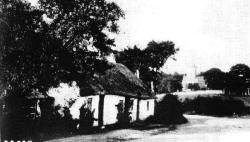 |
| fig. 2 : Samuel Dugan. (1859-1910) outside his blacksmith's shop on the Blllyskeagh Road, just beyond just beyond the parochial hall. His family, are from left to right, Robert, George, Hill and Sadie. The photograph was taken c. 1905. | fig. 3: Cottages on the Ballyskeagh Road, opposite the blacksmith's shop, c. 1900 Samuel Dugan raised his family in one of these dwellings. The photograph appears to have been taken from (roughly) where the bungalow Richview now stands. (Photograph courtesy of Mrs. McNiece, Drum House) |
In these Drumbeg articles, published in this Journal by the author since 1982 the main focus has been on important local families and their seats and on events which took place in the area. Little has been said about the lives of the ordinary people, for obvious reasons; such persons are not recorded in history books and it is generally only family historians who pick up their trails when researching their own particular backgrounds. The Dugan family, ancestors of the author on her mother' s side, lived around Drumbeg from the early nineteenth century. The men in the family - certainly until the middle of the century - were generally labourers, although the earliest recorded member James, was a drover. By the 1880s, trades such as blacksmithing and plumbing had begun to enter the family tree. Samuel Dugan (1859 - 1910), referred to above, had his smithy on the bend of the Ballyskeagh Road, just beyond and on the same side as, the parochial hall. A 'well-doing' man and a Worshipful Master of the local Orange Lodge in 1902, he lived in a thatched cottage opposite the forge and augmented his income by raising cattle in the nearby fields. His descendants remained in the area for many years; several are buried in the graveyard close by.
For working folk in the area, employment could be had in the Drum Corn Mill and later, the Ulster Dye Works (that is, apart from work on the land or in service in one of the large houses in the locality or in towns like Belfast and Lisburn). The corn mill, shown on the Ordnance Survey Map of 1860 (and described simply as a mill on the 834 map), was situated on the spot where the Ulster Dye Works formerly stood and where The Hermitage private housing estate now stands. The mill may have been the property of W. Greenfield owner of Drum House; both mill and house were being advertised for as being for sale in October 1873.(14) The advertisement for the mill drew attention to the fact that the property 'might be made available for Dyeing and Finishing purposes: It seems possible, therefore, that the mill was subsequently converted into a dye works - and thereafter became the Ulster Dye Works (fig. 4). This latter concern, owned by the Thompson family, was opened c. 1892 and remained in business until 1965.(15) The firm, which was both a dye works and a patent steam carpet beating works had an office in Belfast, for city-based trade. By 1951, it had added dry cleaning to its operations. After closure, the premises lay vacant for many years. In recent times, the Hermitage estate was erected on the site.
Robert Stewart's public house was undoubtedly important to the working population. The history of Bob Stewart's remains obscure. Although a building is shown on the 1834 Ordnance Survey map as being in the same position as the present public house, the structure may simply have been a cottage or a row of small dwellings. There was a Bryce (or Brice) Stewart of Drumbeg, publican, living in the area in 1838; however, whether Bob Stewart was descended from him or related to him is unknown - there are numerous Stewarts in Drumbeg church records. One fact is certain: Stewart's pub was in business by the early years of the present century; a family heirloom, inscribed with Stewarts occupation and place of business, is dated 1913. An early photograph of the building (fig. 5), showing Stewart outside the pub, probably dates from about this period. Stewart died in 1966, aged eighty-seven. After his death, his wife Ellen (nee Dugan) ran the business until her death in 1972. Thereafter, the pub passed to her nephew, George Dugan. A comparison of fig. 5 with a photograph taken in 1980 (fig. 6) shows how the facade was altered at some point, with the addition of a porch and pebbledash (the earlier building had been whitewashed).
![]()
In March 1991, the business was declared bankrupt. After lying empty for several months, the pub went on the market in April 1992 and was subsequently purchased by
Jack Gilmour. Reopened in 1993, it has been modernised and improved; however, much of the old character still remains. As the 'old' Bob Stewarts was a lively part of Drumbeg, so
the 'new' one has also become. The renaissance of the pub is, in a way, a fitting end to this series of articles, which have been about change - and continuity - in this picturesque and interesting pocket of the
Lagan Valley.
References
| 1. | See 'A glimpse of Drumbeg, 1750-1800; Lisburn Historical Society Journal Volume 7 1989 and 'Drumbeg 1800-1860,' Lisbum Historical Society Journal Volume 8 1991. |
| 2. | Paul Larmour, Belfast: An illustrated architectural guide. 1987. |
| 3. | Belfast Newsletter, 17 December 1870. |
| 4. | See Eileen Black, 'Ballydrain, Dunmurry - an estate through the ages, 'Lisburn Historical Society Journal, vol. 5, December 1984. Additional information supplied by Matthew Neill, 10th May 1993. |
| 5. | Hugh Dixon, 'Honouring Thomas Jackson (1807-1890)(Architect), Proceedings and Reports of the Belfast Natural History and Philosophical Society. Sessions 1970 / 71 - 1976 / 77, Second Series, vol. 9. |
| 6. | See Fred Heatley's notes in the Linen Hall Library reprint of Proctors Belfast Scenery 1983. |
| 7. | For details of the Charleys, see Irene H. Charley, The Romance of the Charley Family, 1970. |
| 8. | Information from J. Sloan,headmaster of Charley Memorial Primary School, 30th April 1993. |
| 9. | Northern Whig, 7th April 1896. |
| 10. | See Eileen Black, 'Wilmont, Dunmurry: A Profile, 'Lisburn Historical Society Journal , vol.4, December 1982. |
| 11. | A photograph of L.O.L. 638, dating from c.1905, is in PRONI, D3670/B/15. |
| 12. | Northern Whig, 19th May 1883. |
| 13. | Ibid., 12th November 1890. |
| 14. | Belfast News-Letter. 15 October 1873 |
| 15. | Belfast directories 1890-1971 |
Eileen Black is an Assistant Keeper in the Ulster Museum's Art Department, with curatorial responsibility for the pre-twentieth century oil painting collection. She regards her Drumbeg articles as a personal tribute to her Dugan forbears, resident in the area from the early nineteenth century.

